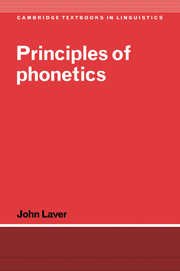Book contents
- Frontmatter
- Contents
- List of figures
- List of tables
- Preface
- Acknowledgements
- Introduction
- PART I General concepts
- PART II The analytic framework
- PART III Initiation and phonation
- PART IV Linear segmental analysis
- PART V Articulatory co-ordination and phonetic settings
- PART VI Temporal, prosodic and metrical analysis
- PART VII Principles of transcription
- PART VIII Conclusion
- 19 Evaluating general phonetic theory
- Envoi
- Appendix I The phonetic alphabet of the International Phonetic Association
- Appendix II Index of languages
- References
- Index of names
- Subject index
19 - Evaluating general phonetic theory
Published online by Cambridge University Press: 05 June 2012
- Frontmatter
- Contents
- List of figures
- List of tables
- Preface
- Acknowledgements
- Introduction
- PART I General concepts
- PART II The analytic framework
- PART III Initiation and phonation
- PART IV Linear segmental analysis
- PART V Articulatory co-ordination and phonetic settings
- PART VI Temporal, prosodic and metrical analysis
- PART VII Principles of transcription
- PART VIII Conclusion
- 19 Evaluating general phonetic theory
- Envoi
- Appendix I The phonetic alphabet of the International Phonetic Association
- Appendix II Index of languages
- References
- Index of names
- Subject index
Summary
The study of speech was described in the Introduction as covering ‘a remarkably wide domain, embracing aspects of the social sciences, the life sciences, the physical sciences, the engineering sciences and the information sciences’. As one might imagine in a field which attracts the interest of so diverse a range of disciplines, each of these specialisms has developed its own perspective on speech, coloured by the conceptual filter through which it views its own subject (Beckman 1988). One might then ask whether there is some common framework of understanding about how speech works and how it is used, which all these subjects share. To the extent that an answer exists, it is probably fair to say that the only well-developed model of speech description which commands really widespread international acceptance is the one represented by the International Phonetic Association's phonetic alphabet, with its attendant segmentally oriented assumptions.
It was suggested in section 5.2 that the classificatory architecture shaping the IPA alphabet has remained largely unchanged for over a hundred years, even after the adjustments made by the 1989 Kiel Convention. The IPA alphabet thus has the great strength of having withstood the test of time. Its prime virtue lies in offering a readily understandable, reasonably objective and above all internationally accepted and standard means of describing the substance of speech, usable by phonetic research of all varieties as a point of departure into more specialized and diversified territory.
- Type
- Chapter
- Information
- Principles of Phonetics , pp. 565 - 591Publisher: Cambridge University PressPrint publication year: 1994



